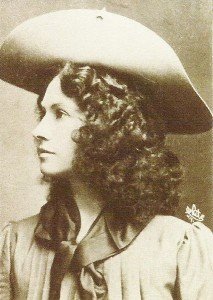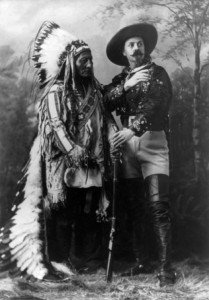Buffalo Bills Wild West Goes To Europe
Buffalo Bill Cody’s Wild West was probably the greatest show on earth. During the latter part of the 1800’s the majority of the population was east of the Mississippi River. Newspaper accounts of course supplied the eastern populace with news stories of the Indian Wars and the ongoing westward migration. Mostly because of the news accounts, people in the East were eager to learn more about the American West. What was it really like? Who were these mountain men and Native American warriors we heard so much about? What was it like to be under attack by hostiles? These questions and more were answered by William Cody and his performers. When you look at old pictures of the Wild West you can see how William Cody was a promotional genius in his era.

The Wild West shows played to packed audiences in the United States before venturing overseas to Europe. The Europeans, some might say, even more than some Americans were absolutely captivated by stories of the American West. Books and dime novels were quite popular in Europe. One of the most popular acts in the Wild West was the sharpshooter Annie Oakley. Annie and her husband and business manager, sharpshooter Frank Butler, toured all the venues in Europe and thrilled the crowds.
England in 1887
In 1887 the Wild West toured England to sell out crowds. Queen Victoria, the Prince of Wales and many other society figures came out to see the Wild West. The show played in London, Birmingham and Manchester England. The story of the wild west was just as the English anticipated and they loved the show. Among the features were real Indians attacking a stagecoach and driven off. A reenactment of the Battle of the Little Bighorn was performed with a bit of a different outcome. Most historians seem to agree that Wild Bill Cody embellished some of the scenes for entertainment value. Nevertheless, it was enthusiastically accepted by the audience. When Europeans wanted to see the wild west Buffalo Bill Cody brought it to their doorstep.

Wild West in Italy
In 1889 Cody’s show returned to Europe including a tour in Italy. While in Rome where they were invited to the Vatican to attend the celebration of the tenth anniversary of the coronation of Pope Leo XIII. A very publicized event while the Wild West was in Italy was a bronco-busting challenge between Buffalo Bill’s cowboys and true working cowhands from the Maremma region in central Italy. These men spent much of their time working with the Cajetan breed of horse, the wildest most untamed in Italy. The Prince of Teano challenged Cody’s men to break the Cajetans. Twenty thousand spectators saw the contest. There were mixed reports on the contest’s outcome. Most reports however were that the Maremma cowboys were only marginally to moderately successful at trying to duplicate that feat on Cody’s horses.
Many people assume that the Wild West was performed in Rome’s historic Coliseum. The fact was that there were too many stones and debris in the arena and the Wild West simply posed at the Coliseum for pictures. Tents were erected there but because of the debris and lack of sufficient space the performances couldn’t be staged at the very historic site.

The Wild West performed for eight days in Bologna. In Bologna there were congested streets and oversold arenas. It was in Bologna that American popcorn was introduced to audiences giving them a good sample of American culture. It’s interesting to observe that during 1890 the Indian Wars had subsided but had not disappeared entirely. The Wounded Knee Massacre of Sioux in 1890 is an example. In 1890 the Census Bureau officially declared the end of the frontier. That was somewhat true and the Indian Wars died down but there were still many Native American issues unresolved.
Nobody in Italy considered the Wild West show to be merely a circus. It was more of a display of current events in a way. At least that was the feelings of both William Cody and his Italian audiences. A good example of the realness of the Wild West were the Indians themselves. These were not professional actors.They were real Native Americans and some of them were believed to have participated in the Battle of the Little Big Horn against Custer.
Some of Cody’s warriors had actually been in custody because of earlier uprisings and only released to Buffalo Bill to tour with his troupe. For the people of today who became acquainted with the 1800’s wild west via movies and television, they would have a hard time understanding what it was like for Europeans, including the Italians, to see a live display of this kind.There has been nothing like it since and probably never will be. Bear in mind that in the late 1800’s, media was nothing like it was now. People attained their knowledge of current events through printed means such as newspapers, books and magazines. Live plays typically didn’t involve current or somewhat recent events. Buffalo Bill brought the live action to the audiences with authentic performers and it was hugely successful. Many people believe that the 20th century movie makers drew their interpretation of the wild west from William Cody’s productions.

When the Wild West show went to Florence for a three day engagement, the reception was the same. The whole town turned out. An estimated 10,000 people daily attended the performances. Newspapers at the time reported that the act the Florentines enjoyed the best was the Indian attack on the Deadwood stagecoach. The Indians looked like they had the upper hand but at the last minute the cavalry appeared to rescue the stage and it’s passengers. Ironically, it wasn’t that many years since these events actually happened in real life. This is just another reason why the show was regarded as much as a news event rather than only entertainment.
Two additional articles with photos you’ll be interested in are Annie Oakley and Frank Butler and the story of the Wild West Touring Paris.
The Wild West Remains Popular
Stories of Buffalo Bill were popular many European countries in the early 20th century, The Nerbini publishing company in Florence started publishing in an illustrated format the adventures of “Buffalo Bill, The Hero of the Wild West“. Historians have long debated and discussed the meaning of the Wild West performances, especially the enormous drawing power they enjoyed. As an example, a newspaper in Florence while the show was performing there, pointed out that the Wild West really was a story of a dying race. The paper further pointed out to history students in the area to make certain to meet the Indian performers since they represented a people who would vanish from the earth. The paper was pointing out that the story of the disappearing Native American was actually a side theme of most of the acts.
Historians can and have debated this issue and I feel they are partly right. Right or wrong wasn’t part of the performance. That wasn’t the intent of Cody’s show. The show did an excellent job chronicling the old wild west and it accomplished that with flair. There’s no question that some acts were embellished but such is the norm in show business. News accounts at the time stated that many Florentines wandered the show grounds particularly interested in seeing the Indians close up. The audiences loved the show despite what some single critic might have had to say. The Florentines were awed by the sight of the warriors, especially when they had their war paint and headdresses on and shouted a war cry.

Buffalo Bill Cody made a fortune with his Wild West. He didn’t use or like the word “show’, possibly because he thought it had the connotation of being phony or fake. That is the reason the performances were called the “Wild West” without using the word “show” although you do see the word “show” used in some research pieces. Every indication from the research I have seen is that William Cody believed he was presenting a piece of very unique history. William Buffalo Bill Cody died in January 1917 in Denver Colorado. When word of Cody’s passing reached overseas, tributes came in from European leaders all over the continent. That was testament to the lasting mark he made to people from all over the world.
(Photos from the public domain)
